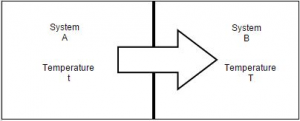Question

a.
Temperature difference
b.
Energy difference
c.
Mass difference
d.
Volumetric difference
Posted under Heat Transfer
Interact with the Community - Share Your Thoughts
Uncertain About the Answer? Seek Clarification Here.
Understand the Explanation? Include it Here.
Q. Consider system A at uniform temperature t and system B at another uniform temperature T (t > T). Let the two systems be brought into contact and be thermally insulated from their...
Similar Questions
Explore Relevant Multiple Choice Questions (MCQs)
Q. The literature of heat transfer generally recognizes distinct modes of heat transfer. How many modes are there?
View solution
Q. An oil cooler in a high performance engine has an outside surface area 0.12 m² and a surface temperature of 65 degree Celsius. At any intermediate time air moves over the surface of the cooler at a temperature of 30 degree Celsius and gives rise to a surface coefficient equal to 45.4 W/ m² K. Find out the heat transfer rate?
View solution
Q. Unit of rate of heat transfer is
View solution
Q. Convective heat transfer coefficient doesn’t depend on
View solution
Q. The rate equation used to describe the mechanism of convection is called Newton’s law of cooling. So rate of heat flow by convection doesn’t depend on
View solution
Q. How many types of convection process are there?
View solution
Q. Thermal conductivity is maximum for which substance
View solution
Q. A radiator in a domestic heating system operates at a surface temperature of 60 degree Celsius. Calculate the heat flux at the surface of the radiator if it behaves as a black body
View solution
Q. Which of the following is an example of forced convection?
View solution
Q. Regarding one dimensional heat transfer, choose the correct statement
View solution
Q. Which statement is true regarding steady state condition?
View solution
Q. Which of the following is an example of steady state heat transfer?
View solution
Q. Heat transfer in a long, hollow cylinder which is maintained at uniform but different temperatures on its inner and outer surfaces may be assumed to be taking place in which direction?
View solution
Q. Heat transfer takes place according to which law?
View solution
Q. Heat transfer takes place in liquids and gases is essentially due to
View solution
Q. The appropriate rate equation for convective heat transfer between a surface and adjacent fluid is prescribed by
View solution
Q. Identify the wrong statement.
View solution
Q. During a cold winter season, a person prefers to sit near a fire. Which of the following modes of heat transfer provides him the maximum heat?
View solution
Q. Most unsteady heat flow occurs
View solution
Q. During the unfolding reaction of a helix, breakage of each hydrogen bond requires about 2kJ/mol. This implies hydrogen bonds are
View solution
Recommended Subjects
Are you eager to expand your knowledge beyond Heat Transfer? We've handpicked a range of related categories that you might find intriguing.
Click on the categories below to discover a wealth of MCQs and enrich your understanding of various subjects. Happy exploring!








